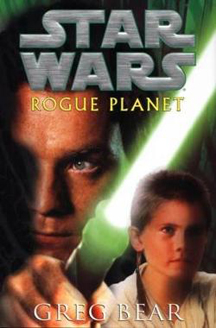Greg Bear’s “Rogue Planet” is a schizophrenic novel. It’s hard to read, but it’s filled with fascinating ideas. It’s packed with information that’s seemingly crucial to future stories, yet those future stories tend to ignore or contradict what happens here. In some ways it’s an essential read, in other ways it’s skippable.
If you want to learn about Anakin age 10-19 (the years between Episodes I and II), “Rogue Planet” is your best option. Anakin is largely absent from the comics during this time period. As for the two other novels in this period: He’s a supporting character in “Outbound Flight” and “The Approaching Storm” is set just prior to “Episode II.” Bear does a masterful job of writing Anakin. At first, I pictured him as Jake Lloyd, but by the end I was picturing Hayden Christensen. The cover artist blends the two actors to show us a 12-year-old Anakin.
Anakin takes a key step on his journey to the Dark Side when he kills a Blood Carver by crushing his insides with the Force, a popular method of Darth Vader years later. Although it was in self-defense, Anakin is horrified by the idea that he went too far and that he can’t control his power. Similarly, when he kills the Tusken Raiders in “Episode II,” he confesses to Padme that he shouldn’t have killed everyone in the camp – although I think he was justified in killing those directly responsible for kidnapping and torturing his mom. In “Episode III,” of course, he goes completely over the edge by killing younglings. Unless you count his fistfight with Greedo in the “Episode I” novel or Yoda’s uncorroborated warnings about the fear inside Anakin, “Rogue Planet” marks the first sign of darkness in Anakin.
“Rogue Planet” also introduces us to Tarkin (not called by his first name, Wilhuff, presumably because Bear didn’t know Tarkin’s first name) and Raith Sienar – later the head of Sienar Systems, the designer of many Imperial ships. While spitballing ideas, they come up with an early design for the Death Star, and in the book’s coda, we learn that Tarkin takes credit for the Death Star design from Chancellor Palpatine. This seems to be contradicted by “Attack of the Clones,” where it appears the Geonosians designed the Death Star, but Wookieepedia says that Palpatine shepherded the Death Star idea from Tarkin to Bevel Lemelisk to the Geonosians, who ultimately perfected it.
“Rogue Planet” also features the first meeting of Tarkin and Anakin, and that’s something George Lucas directly contradicts when the pair meets “for the first time” less than a decade later in “The Clone Wars.” It seems unlikely that Anakin would not recognize someone who captured and threatened him on the Zonama Sekot mission, arguably his first dangerous mission as Obi-Wan’s Padawan.
Intriguingly, Qui-Gon’s ghost seems to be giving advice to Anakin and Obi-Wan through much of “Rogue Planet.” Eventually, both of them determine that it’s not Qui-Gon, but rather voices in their heads. Anakin believes it’s Future Anakin (I pictured the “Clone Wars” version) talking to him – a clever way for Bear to show Anakin’s growing maturity.

I think one could argue that it actually is Qui-Gon talking to them. Bear rejected that idea because, as far as he knew based on “The Phantom Menace,” Qui-Gon did not become a Force ghost. The story works beautifully, though, if we imagine it is Qui-Gon in his early stages of becoming a Force ghost. At the end of “Episode III,” when Obi-Wan is astonished to learn that Qui-Gon can communicate from beyond the grave, it’s not essential that Qui-Gon never communicated with Obi-Wan before that. It’s only essential that Obi-Wan not be aware that Qui-Gon was talking to him (as such, Obi-Wan loses his memory of the Mortis arc in “The Clone Wars”).
While Lucas made mincemeat out of Bear’s ideas, “Rogue Planet” was treated with reverence by the authors of the “New Jedi Order” series, which launched one year before this book came out. Bear introduces three concepts central to that series, which takes place decades later on the timeline. Most of the fascinating ideas I mentioned above have to do with the titular Zonama Sekot. It’s a living planet, and the author evocatively (if slowly) illustrates this by showing Anakin and Obi-Wan acquiring seed-partners, which then – after a ritual-laden ship-building process — become elements of a living ship.
Additionally, in a story that happens off-page before this book began but of which we get vague hints, we learn that the Jedi Vergere visited Zonama Sekot, was present for an alien invasion by the Far Outsiders (the Yuuzhan Vong, as “NJO” readers could surmise), and then agreed to depart with the Vong if they’d call off the invasion. Vergere wanted to learn about the Vong and the Vong wanted to learn about the galaxy they were considering attacking.
“Rogue Planet” is a book of ideas – great ideas, in fact – but it is a tough read. The plot is barely short-story worthy: Obi-Wan and Anakin investigate Vergere’s disappearance, while Tarkin and Sienar lurk on their tails and aim to acquire a fabled Sekotan ship by force. Two-thirds of the way through “Rogue Planet,” not much has happened, and when Bear does get around to the climactic battle scenes, they are rather standard. Still, the concept of organic shipbuilding is brilliant, and the continuity paths not taken are fun to think about, making “Rogue Planet” into a rogue novel on your “Star Wars” bookshelf.

